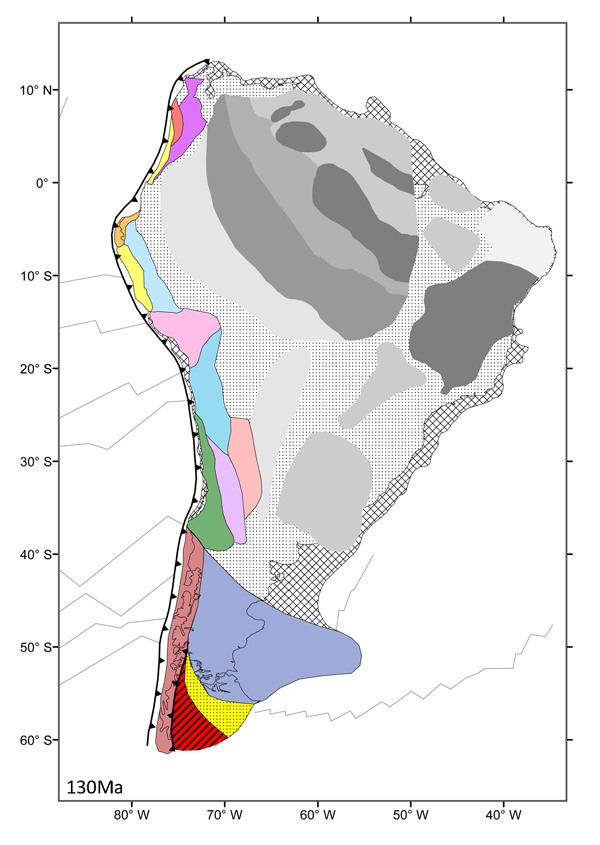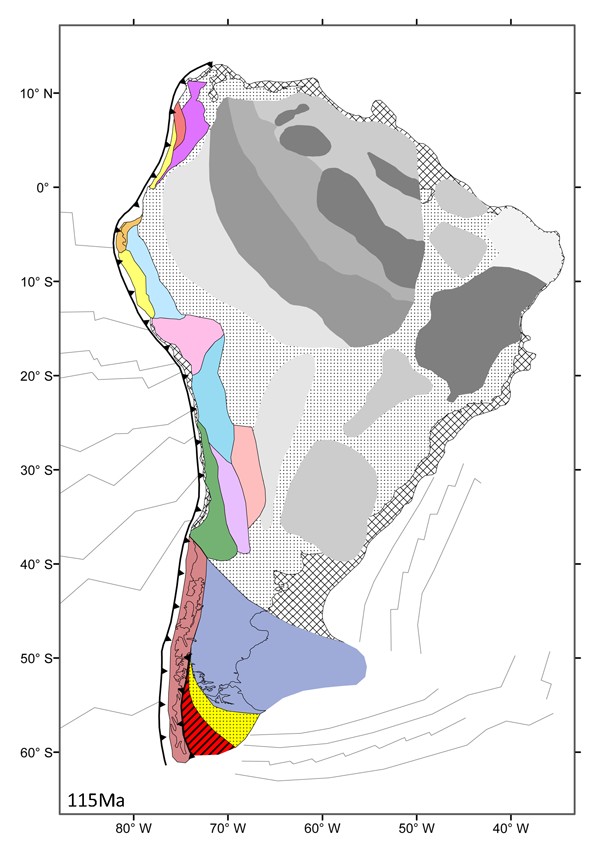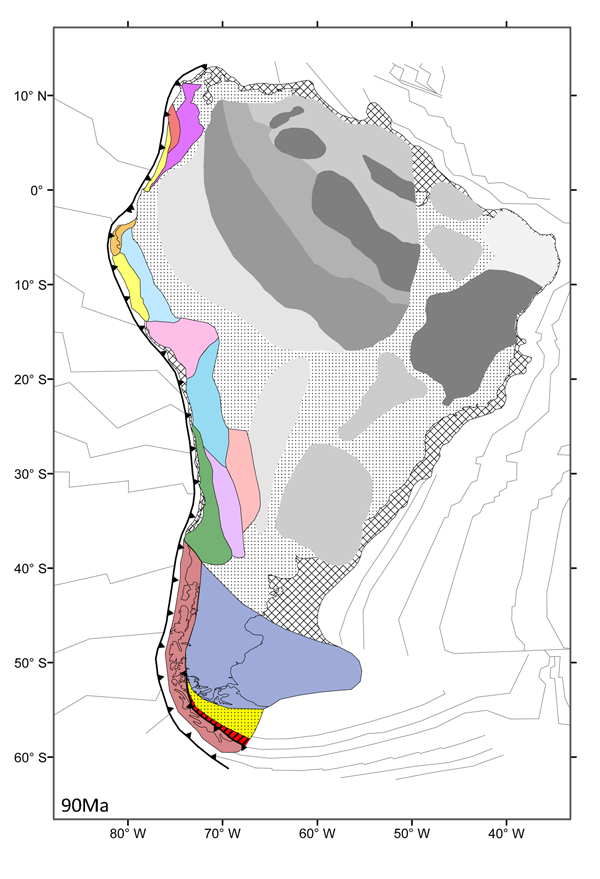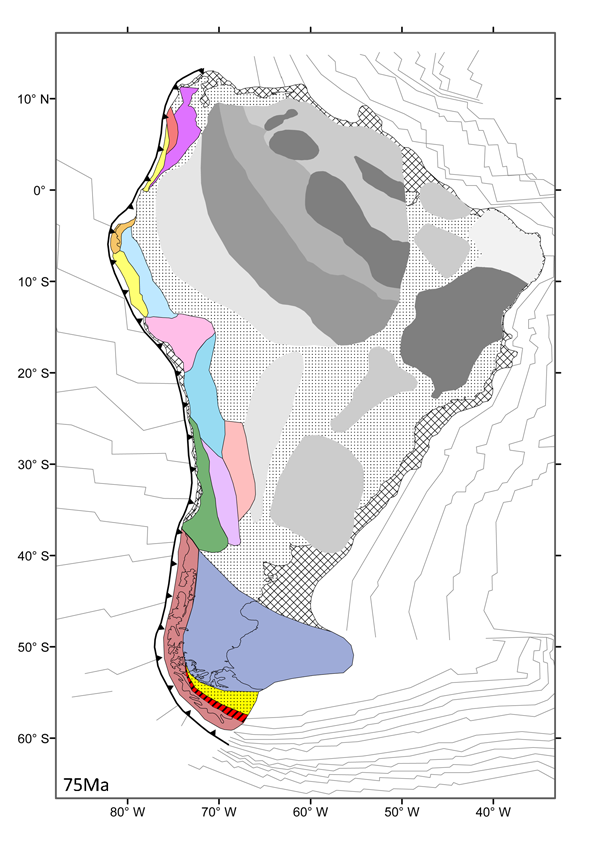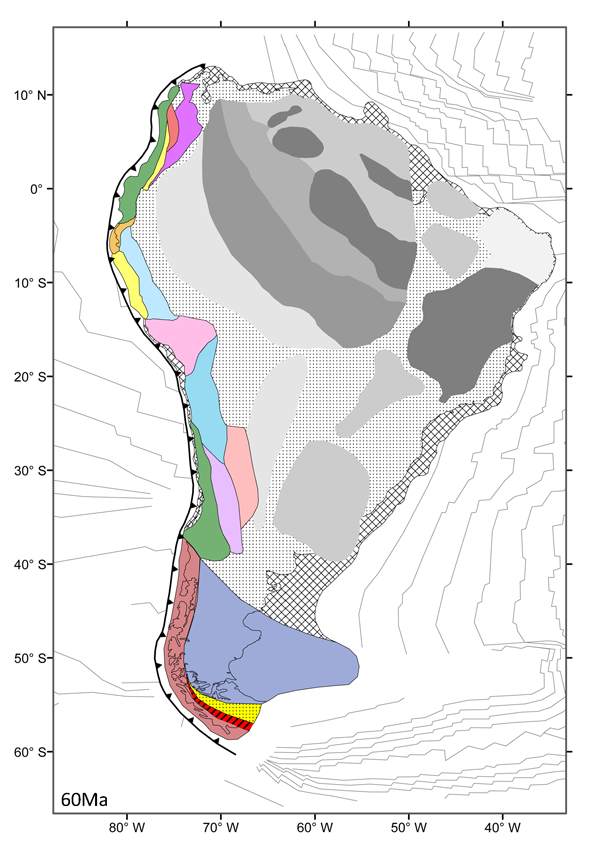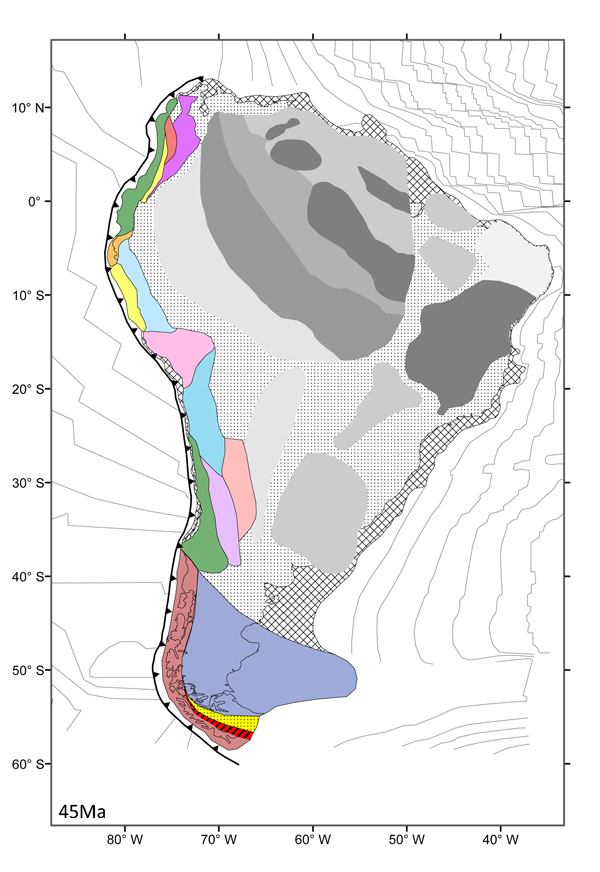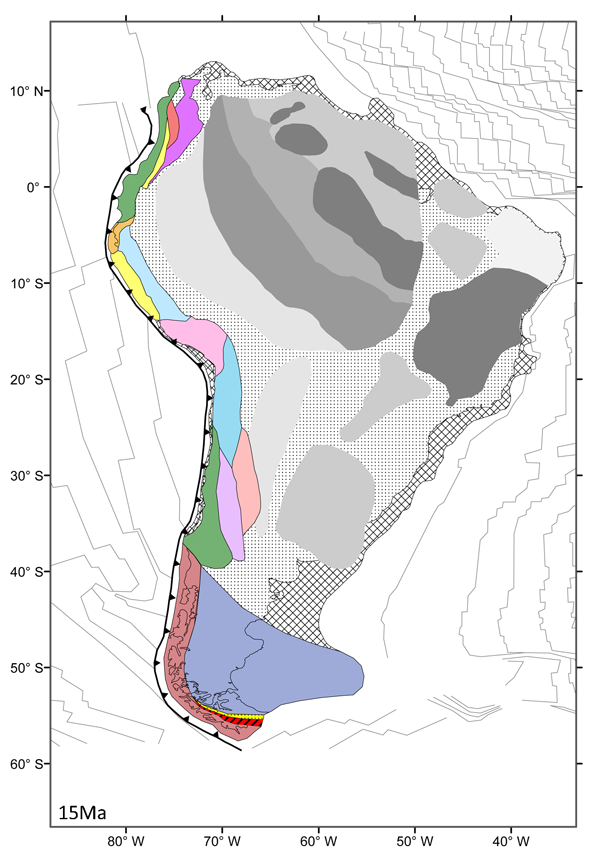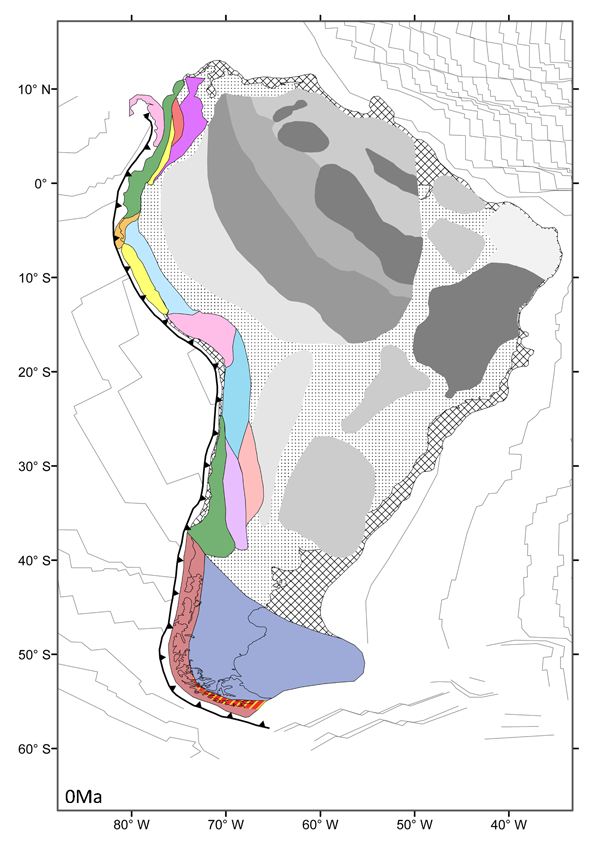Tectonic model
145 to 130 Ma (Figure 3a-b)
As a consequence of restoring the Bolivian and Patagonian Oroclines the Central and Southern sections of the Andes form a sublinear trend at the start of the Early Cretaceous. Extensional forces associated with Gondwanan break-up results in the development of the Rocas Verdes Basin of Southern Patagonia. The Rocas Verdes Basin reaches its full extent during the Early Cretaceous (Kraemer, 2003). The western margin of the Rocas Verdes Basin is composed of magmatic arc fragments, while the eastern margin is composed of units including the Cordillera Darwin Complex (e.g. Kraemer, 2003). Continued break-up of Gondwana also results in westwards displacement of Patagonia relative to South America, along the right-lateral Gastre Fault System (Rapela and Pankhurst, 1992).
Figure 3a. Geodynamical reconstructions 145 Ma.
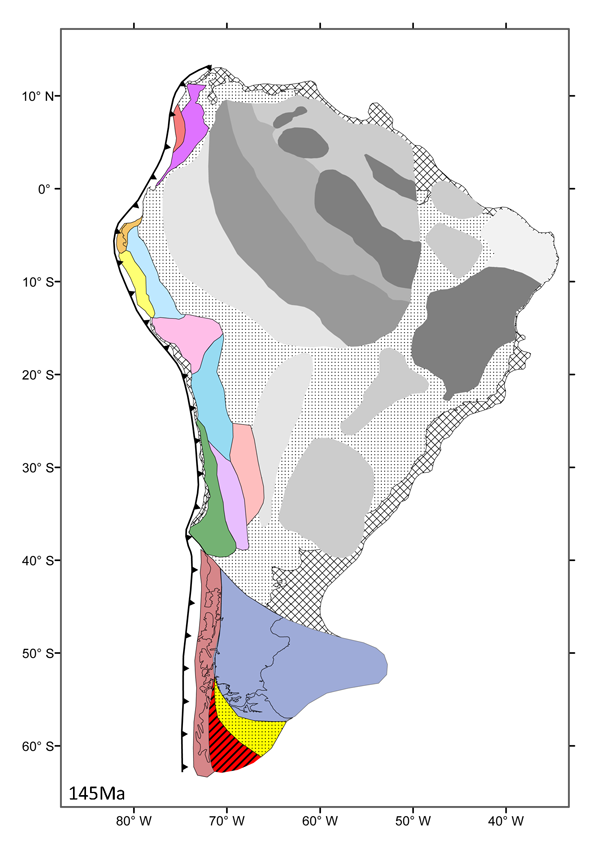
Refer to text for details. Colours are the same as in Figure 1. Isochron data for Figure 3b-j from Müller et al. (2008).
130 to 90 Ma (Figure 3b-d)
Patagonia reaches its present-day position as major displacement along the Gastre Fault System ceases (Konig and Jokat, 2006). Rotation of the Southern Patagonian magmatic arc initiates, with a hinged-point, located at approximately 50°S, resulting in the majority of rotation occurring at the southern extremity of the arc. Rifting continues between Africa and South America and results in changes in convergence rates, and intensifies compression in southern Patagonia (Diraison et al. 2000). A compressive event occurring in the mid-Cretaceous causes orogenic shortening that reaches a maximum of 430 km during this time period (Kraemer, 2003). This compression is related to an 87–90 and 100–110 Ma deformational event, as described within Halpern and Rex (1972). Orogenic shortening is accommodated by folding and thrusting of the Cordillera Darwin Complex, and reverse subduction of Rocas Verdes Basin oceanic lithosphere beneath the Southern Patagonian magmatic arc (Kraemer, 2003). This reverse subduction results in the closure and eventual inversion of the Rocas Verdes Basin (Halpern and Rex, 1972; Dalziel et al. 1974). As detailed by Diraison et al. (2000), during the Late Cretaceous the Cordillera Darwin experiences a major period of uplift and cooling (Dalziel and Palmer, 1979; Nelson et al. 1980; Nelson, 1982; Dalziel, 1985; Dalziel and Brown, 1989; Kohn et al. 1993; 1995; Cunningham, 1995). In this reconstruction we have modelled this uplift as overthrusting to the NE and left-lateral wrenching (Klepeis, 1994; Diraison et al. 2000; Kraemer, 2003).
Accretion of the Amaime island arc occurs along the western margin of the Cordillera Real (Aspden and Litherland, 1992; Litherland et al. 1994). The Romeral-Peltetec faults system exhibits high-pressure assemblages and metamorphic units and is inferred to have been the suture along which this accretion event occurred (Bosch et al. 2002; Ramos, 2009). Blueschists associated with the Raspas Ophiolitic Complex have been K-Ar dated at 132, Ma and are considered to represent the emplacement of the Amaime arc terrane (Feininger et al. 1982; McCourt et al. 1984). This accretion event occurs prior to the Late Cretaceous collision of a plateau, as detailed by Pindell and Tabbutt (1995) and Alemán and Ramos (2000).
90 to 60 Ma (Figure 3d-f)
The Northern Andean margin experiences a collision with an oceanic plateau during the Late Cretaceous (Pindell and Tabbutt, 1995; Alemán and Ramos, 2000). Palaeomagentic data suggest that a single oceanic plateau collides with the Northern Andean margin and later fragments (Luzieux et al. 2006), contrasting to the concept of a series of collisions as proposed by Kerr et al. (2002). U-Pb SHRIMP data validate the single collision concept (Vallejo et al. 2006). This is modelled as the accretion of the Dagua-Pinon terrane, which extends from Columbia down through Ecuador, and is dated as accreting between 75-65 Ma (Alemán and Ramos, 2000; Cediel et al. 2003). A magmatic arc on the Central Cordillera of Columbia and Cordillera Real of Ecuador is active until the Late Cretaceous (Ramos, 2009). Ramos (2009) suggests the Paleocene granites associated with the Antioquia batholith may be related to an episode of slab break-off that occurs in the northern Central Cordillera.
Closure of the Rocas Verdes Basin and crustal shortening of the Cordillera Darwin continues, with approximately 40 km occurring during the Late Cretaceous (Kraemer, 2003).
60 to 30 Ma (Figure 3f-h)
Crustal shortening of the Central Andes commences during the Mid-Eocene (McQuarrie, 2002; Arriagada et al. 2008), likely as a consequence of the Central Andean 37 to 25Ma flat-slab episode (O’Driscoll et al. 2012). Horizontal shortening is focused in the Eastern Cordillera (Arriagada et al. 2008). Varying degrees of along-strike shortening causes bending of the Central Andes and formation of the Bolivian Orocline (Arriagada et al. 2008). The relationship between the basement highs and the physiographic boundaries of the Andean Plateau suggests shortening is controlled by the duplexing and stacking of basement megathrusts (McQuarrie, 2002). This protracted shortening generates crustal thicknesses of ~70 km below the highest topography in the Eastern and Western Cordillera (Beck and Zandt, 2002).
30 Ma to Present (Figure 3h-j)
Differential crustal shortening of the Central Andes continues. Despite the extensive crustal thickening associated with this shortening, paleoelevations were less than 2 km in the Altiplano, and 2.5-3.5 km in the Eastern and Western cordilleras until ~10 Ma (Hoke and Garzione, 2008). Removal of dense eclogite and mantle lithosphere changes the internal structure of the Andean lithosphere between approximately 10-6 Ma, triggering regional surface uplift of approximately 1.5-2.5 km (Garzione et al. 2008). The low-relief landscape presently observed in the Andean Plateau was enhanced by way of mass redistribution caused by continued lower-crustal flow, erosion, and sedimentation, from 6 Ma to present (Garzione et al. 2008).
During the Neogene the Rocas Verdes Basin and Cordillera Darwin deformation continues, with approximately 80 km of shortening occurring (Kraemer, 2003). The Patagonian Orocline completes its presently observed 90° rotation (e.g. Cunningham et al. 1991; Maffione et al. 2010).
To the north the Choco terrane accretes onto the Cordillera Occidental (Duque-Caro, 1990). Geochemical and isotopic data suggest the Choco terrane is derived from a different part of the Caribbean Plateau to that of the Dagua-Pinon fragment (Kerr and Tarney, 2005). Duque-Caro (1990) argued that presence of exotic upper Paleocene planktic foraminiferal assemblages suggests the Choco Block originated as distant as the northern latitudes of Guatemala and Mexico. Biostratigraphic dating constrains the age of Choco accretion at approximately 13 Ma (Duque-Caro, 1990). This accretion occurs along the Uramita Fault Zone, which sutures the Choco terrane and the Cordillera Occidental, and entailed major deformation of Middle Miocene formations (Duque-Caro, 1990), the details of which are not modelled in the continental-scale reconstruction presented here.
